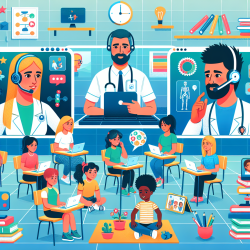The International Journal of Telerehabilitation (IJT) has launched its 5th year of publication with a focus on innovative applications of telerehabilitation. This blog post will delve into the practical implications of the latest research for practitioners, particularly those working with children in school settings.The current issue of IJT features several noteworthy studies:
- Fairman and colleagues present a new mHealth solution to promote wellness in persons with spina bifida.
- Faett and colleagues explore the use of telerehabilitation for self-management of chronic limb swelling in individuals with limited mobility.
- Criss describes a novel use of school-based telerehabilitation to improve handwriting, applicable in traditional, virtual, and home-school settings.
- Hall and colleagues conduct a systematic review on telepractice for assessing and treating aphasia.
Each of these studies provides valuable insights for practitioners looking to enhance their skills through data-driven, evidence-based approaches.
1. mHealth Solutions for Spina Bifida
Fairman and colleagues' research introduces an award-winning mHealth solution aimed at promoting wellness in individuals with spina bifida. This innovative application of telerehabilitation can be adapted for children with similar needs, offering remote monitoring and interventions that can significantly improve their quality of life. Practitioners can leverage this technology to provide personalized care plans and continuous support, thereby enhancing outcomes for their young clients.
2. Self-Management of Chronic Limb Swelling
Faett and colleagues' study on the use of telerehabilitation for managing chronic limb swelling in individuals with limited mobility highlights the importance of self-management. This approach can be particularly beneficial for children with chronic conditions, empowering them and their families to take an active role in their care. Practitioners can incorporate these strategies into their therapy sessions, using remote monitoring tools to track progress and adjust treatment plans as needed.
3. Improving Handwriting through School-Based Telerehabilitation
Criss's research on using telerehabilitation to improve handwriting skills in school settings is especially relevant for practitioners working with children. This program can be seamlessly integrated into traditional classrooms, virtual schools, or home-school environments. By utilizing telerehabilitation, practitioners can provide consistent, high-quality interventions regardless of the setting, helping children develop essential writing skills.
4. Telepractice for Aphasia
Hall and colleagues' systematic review of telepractice for aphasia offers valuable insights into the efficacy of remote assessments and treatments. While the focus is on aphasia, the findings can be extrapolated to other speech and language disorders commonly seen in children. Practitioners can apply these telepractice techniques to deliver effective therapy sessions, ensuring that children receive the support they need even when in-person sessions are not feasible.
Interdisciplinary Collaboration
A notable aspect of the research presented in this issue is the interdisciplinary nature of the teams involved. Authors come from diverse fields including information management, linguistics, occupational therapy, medicine, nursing, physical therapy, rehabilitation counseling, rehabilitation engineering, and speech-language pathology. This multidisciplinary approach enriches the research and offers a holistic perspective on telerehabilitation, encouraging practitioners to collaborate across disciplines to enhance their practice.
Encouraging Further Research
The current issue of IJT not only presents innovative applications but also invites practitioners to contribute to the growing body of research in telerehabilitation. By engaging in further research, practitioners can stay at the forefront of their field, continuously improving their skills and the outcomes for their clients.To read the original research paper, please follow this link:
Editors Note: Volume Overview 









